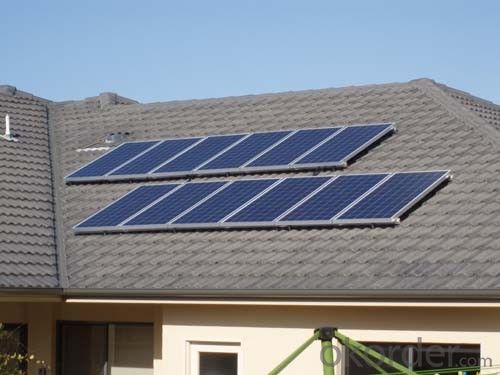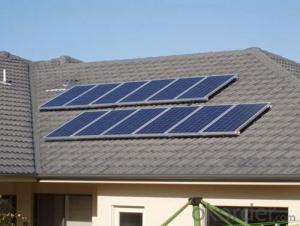Polycrystalline Solar Panel 230W with High Efficiency
- Loading Port:
- Shanghai
- Payment Terms:
- TT OR LC
- Min Order Qty:
- 100 watt
- Supply Capability:
- 10000 watt/month
OKorder Service Pledge
Quality Product, Order Online Tracking, Timely Delivery
OKorder Financial Service
Credit Rating, Credit Services, Credit Purchasing
You Might Also Like
Item specifice
Material:
Polycrystalline Silicon
Max. Power(W):
230
Number of Cells(pieces):
60

Product Description
230W Poly Crystalline Solar Panel
Product Highlights:
1. Guarantee positive power tolerance (0~+3%)
2. Module can bear snow loads up to 5400Pa and wind loads up to 2400pa
3. High performance under low light conditions (cloudy days, mornings and evenings)
4. Certified by Europe standards of TUV, IEC, CE and British MCS and AUS CEC
5. OEM/ODM available
Specs
| Electrical Characteristics | |
| Maximum Power [Pmax] | 230W |
| Power Tolerance | +/-3% |
| Maximum Power Voltage [Vmp] | 29.40V |
| Maximum Power Current [Imp] | 7.83A |
| Short-Circuit Current [Isc] | 8.52A |
| Open-Circuit Voltage [Voc] | 36.7V |
| Module Efficiency | 14.14% |
| Max. System Voltage | 1000VDC |
| Cell Size and Series | Poly 156*156 60pcs (6*10) |
| Temperature Coefficient of Pmax | - 0.47% / º C |
| Temperature Coefficient of Voc | - 0.33% / º C |
| Temperature Coefficient of Isc | 0.05% / º C |
| Mechanical Characteristics | |
| Dimension (mm) | 1640*992*40 |
| Frame | Anodized Aluminium Alloy |
| Glass | 3.2mm,High Transmission,Tempered Glass |
| Junction box & Cable | IP65 Rated weatherproof connectors Cable: TUV 1x4.0mm2 / UL12AWG,Length:900mm |
| Weight | 19.0Kgs |
Industry-leading Warranty:
Warranty on material and workmanship: 10 years
Guaranteed output of 90% after 12 years and 80% after 25 years.
- Q:Can solar panels be installed in rural areas?
- Yes, solar panels can be installed in rural areas. In fact, rural areas often have more space and sunlight, making them ideal for solar energy generation. Installing solar panels in rural areas can provide access to clean and renewable energy, reduce reliance on fossil fuels, and bring electricity to remote communities that are not connected to the grid.
- Q:When you add a load resistor to a PV panel (Solar panel) of 00 ohms what happens to the voltage produced from the cellAlso, as the resistance increases, how does this affect the output voltage
- Solar Panel Load
- Q:Can solar panels be installed on a residential community?
- Yes, solar panels can be installed on a residential community. Many residential communities are adopting solar energy as a sustainable and cost-effective alternative to traditional electricity sources. Installing solar panels in residential communities can help reduce energy costs, decrease reliance on fossil fuels, and contribute to a cleaner and more sustainable environment.
- Q:How do solar panels affect roof warranty?
- Solar panels can potentially affect roof warranties because their installation requires drilling holes in the roof, which can compromise its integrity. However, many solar companies offer warranties that cover any damages caused by the installation process, ensuring that the roof warranty remains intact. It is important to check with both the solar company and the roofing manufacturer to understand the impact of solar panels on the roof warranty.
- Q:I want to be more self sufficient and get solar panels for electricity in a small house any tips will help. i need to know how many watts is enough and ect.
- That's okorder , they have been extremely helpful from the initial planning process to the installation and upkeep. Use their Solar Panels Online Solar Sizer to determine how much solar you will require. A lot of it depends on your usage and size of home, but also where in the US you live. Best of luck.
- Q:A homeowner is considering putting a horizontal solar panel on her roof to heat water for domestic use. An average increase of water temperature each day from 60oF to 20oF is wanted for 50 gallons. How large a panel would be needed on a clear winter day at 40o latitude if the overall efficiency is 50%?
- Here's a typical 4' x 8' collector rating. 40 degree latitude would be a cool climate, so you look at row D, water heating in a cool climate. Probably take the middle rating, mildly sunny day, and it is 0,000BTU per panel per day (it's 9,000 on a sunny day). 38,700 BTU / 0,000 BTU = 3.87, they'd need about 3 to 4 panels. If you used the sunny day number, you'd only need 2, but 3 is more realistic, as it is not always a sunny day.
- Q:Can solar panels be used for air conditioning?
- Yes, solar panels can be used for air conditioning. Solar panels generate electricity from sunlight, which can be used to power air conditioning units. By using solar energy, homeowners and businesses can reduce their reliance on traditional electricity sources and decrease their carbon footprint. However, the efficiency and effectiveness of using solar panels for air conditioning may vary depending on factors such as the size of the solar system, location, and energy requirements of the air conditioning unit.
- Q:I have an electric bicycle that I travel to work by, pulling a modified child carrying trailer that holds two 2 volt deep cycle batteries in series to power the 24 volt bike motor. I'm thinking about adding a 50 watt solar panel (or larger depending on the room I can make available) to charge while I'm at work and to provide some extra juice while on my more distant travels.Can I get a solar panel to charge them while they're connected the way they are: in series? Does charging work that way?I've read that in order to charge the 24 volt battery setup (if the answer to the Q above is yes), the output from my solar panel would need to be a little more than 24 volts. Is this true? If so, how many volts?Since the bike is supposed to be powered at 24 volts and I have an x-volt (x gt; 24v) solar panel connected to it, will this cause any damage to the controller or other components while running them?Will it help supply power even while the motor is being run?Thanks.
- Yes, you have it right you need two 2V panels wired in series to give 24V to charge a 24 volt system. But along with the 24V you also want some amperage, otherwise it takes forever to charge. Most of the little chargers are called trickle charges because they only have an amp or two. If you had two 25 watt solar panels putting out 24V you have : watts = volts * amps 50 watt = 24V * x amps x = 2 amps If your battery is say 50 amp hours of storage, then if you are putting in 2 amps it will take you 25 hours of sunlight to power it back up from a dead battery. So the charge time depends on how many amps you are putting in there at 24V A car battery charger typically charges at 0 amps at 2V, so 2 * 0 = 20 watts of power going in there So if you go solar make sure to use a charge controller and a big enough panel to get close to 00 watts for any decent recharge time. The charge controller makes sure that the battery only gets voltage going one way and it least 24V. So if the sun went behind some clouds and the voltage dropped to 20V, the controller shuts off the current until the voltage equals 24V or more
- Q:Can solar panels be installed on billboards?
- Yes, solar panels can be installed on billboards.
- Q:How many solar panels do you need on your house to power your heater in winter?
- Lets assume the panels are 00 Watt panels. You would need 50 panels to just provide power for the heating maybe 2-4 hours a day on nice sunny days. Get the picture? Remember the rating on a panel is peak power when the sun is at just the right position. Solar panels are not normally a good system for heat or air conditioning. They simply get much to large and expensive, and are not reliable because the sun does not always shine. If you are in an area where the electric company will purchase any power you do not use and give you a credit, then you can build a system much larger than you need in the spring and fall and might be able to produce enough during these periods and get a credit. You then use the credits in the winter for heat and in summer for cooling. This requires a detailed study of your uses all year, then designing a system that produces enough to cover your yearly KWH load. It will probably be very expensive, but many are using taxpayer dollars subsidies and electric company rebate programs to make these system more cost-effective. You would need to check your local area utility company.
1. Manufacturer Overview |
|
|---|---|
| Location | |
| Year Established | |
| Annual Output Value | |
| Main Markets | |
| Company Certifications | |
2. Manufacturer Certificates |
|
|---|---|
| a) Certification Name | |
| Range | |
| Reference | |
| Validity Period | |
3. Manufacturer Capability |
|
|---|---|
| a)Trade Capacity | |
| Nearest Port | |
| Export Percentage | |
| No.of Employees in Trade Department | |
| Language Spoken: | |
| b)Factory Information | |
| Factory Size: | |
| No. of Production Lines | |
| Contract Manufacturing | |
| Product Price Range | |
Send your message to us
Polycrystalline Solar Panel 230W with High Efficiency
- Loading Port:
- Shanghai
- Payment Terms:
- TT OR LC
- Min Order Qty:
- 100 watt
- Supply Capability:
- 10000 watt/month
OKorder Service Pledge
Quality Product, Order Online Tracking, Timely Delivery
OKorder Financial Service
Credit Rating, Credit Services, Credit Purchasing
Similar products
New products
Hot products
Related keywords





























